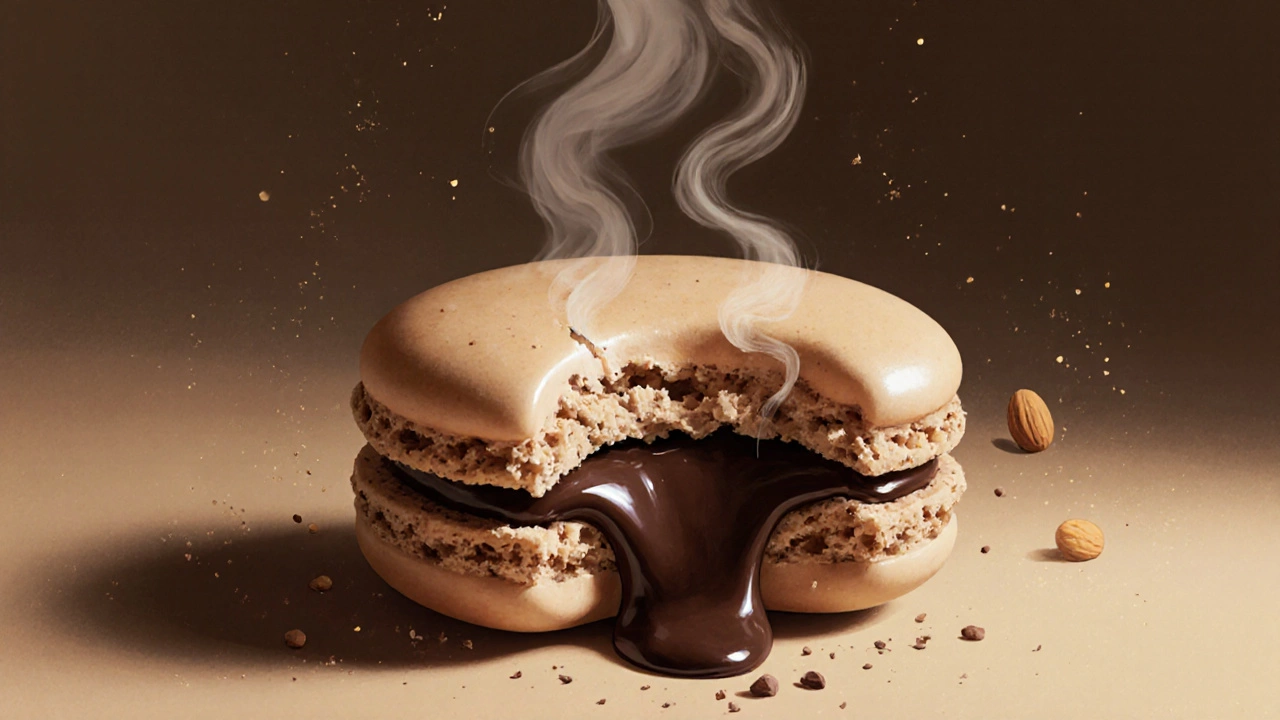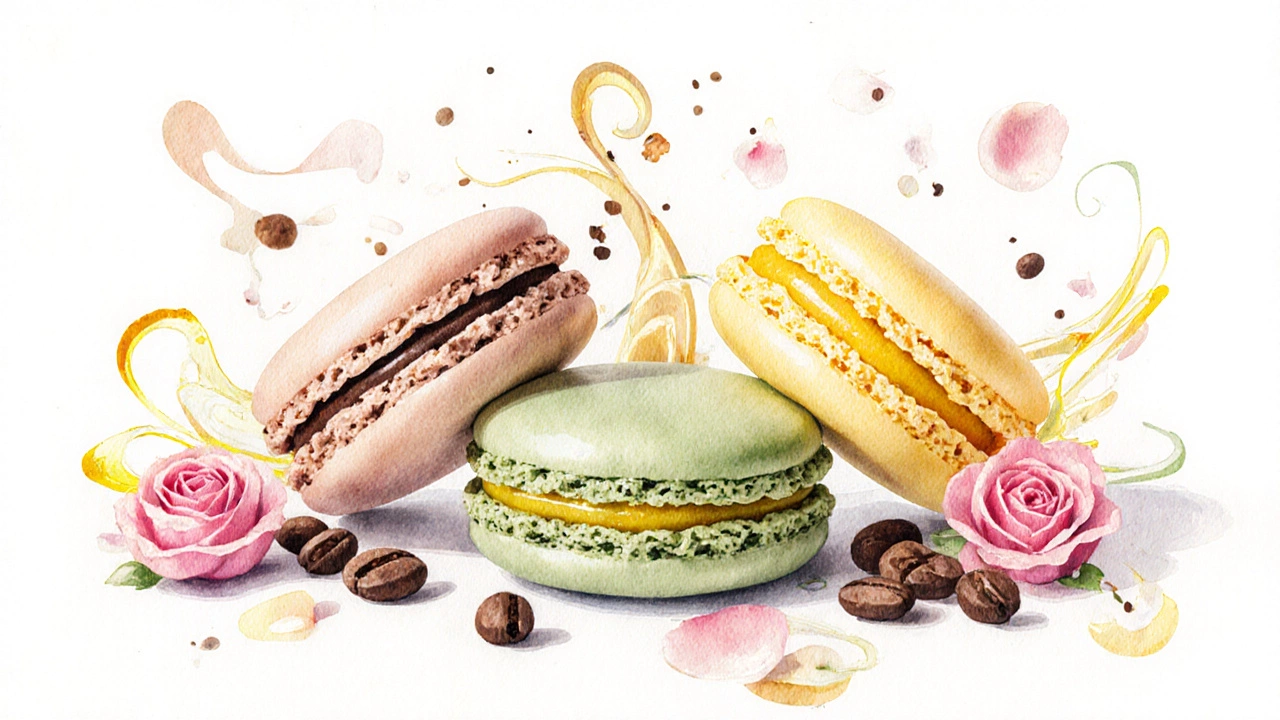Ever taken a bite of a macaron and wondered why it costs so much more than a regular cookie? It’s not just the pretty colors or the fancy packaging. The taste of a macaron isn’t something you can describe with just one word. It’s a quiet explosion - crisp on the outside, soft and chewy inside, and then the filling bursts through like a flavor bomb. If you’ve only ever eaten a store-bought version, you might think macarons are overly sweet. But that’s not the real thing. The best macarons balance sweetness with depth, acidity, and texture in a way that feels almost magical.
The Shell: Crunch, Then Give
The outer shell of a macaron is thin, slightly crisp, and dusted with a fine powder that dissolves the moment it touches your tongue. It’s not hard like a biscuit - it’s more like the shell of a roasted almond, just barely holding together. When you press gently, it gives way. That’s the sign of a well-made shell. Too hard? It’s overbaked. Too soft? It didn’t dry long enough before baking. The texture is the first clue you’re dealing with something special.
The shell itself doesn’t have a strong flavor. It’s made from almond flour, powdered sugar, and egg whites - ingredients that are mild on their own. But that’s intentional. The shell is a canvas. It’s there to let the filling shine. Some bakers add a hint of vanilla or citrus zest to the shell, but purists keep it plain. What you taste here is the texture, not the flavor.
The Filling: Where the Magic Happens
Here’s where macarons break away from every other cookie you’ve ever had. The filling isn’t just a spread - it’s a personality. Buttercream? Ganache? Curd? Jam? Each changes the entire experience.
A classic raspberry buttercream filling is sweet but bright. The buttercream is rich, but the raspberry cuts through it with a tart punch. You get a moment of creaminess, then a sharp burst of fruit. It doesn’t taste like candy. It tastes like a summer afternoon.
Dark chocolate ganache? That’s different. It’s deep, almost bitter, with a silky melt that coats your mouth. The bitterness balances the sweetness of the shell, making it feel sophisticated, not childish. Some bakers add a pinch of sea salt or a drop of espresso to deepen the flavor even more.
Then there’s lemon curd. That’s when you realize macarons can be refreshing. The filling is tangy, almost like a custard, and the shell absorbs just a little of that acidity. It’s not sugary - it’s zesty. You don’t need three. One is enough to make you smile.
It’s Not Just Sweet - It’s Layered
One of the biggest mistakes people make is assuming macarons are just sweet treats. They’re not. The best ones are a study in contrast. Sweet and sour. Creamy and crunchy. Warm and cool. The filling is often chilled, so the first bite is cool, then it warms in your mouth as the buttercream or ganache melts. The shell cracks slightly as you bite - that sound is part of the experience.
Think of it like a fine wine. You don’t taste just one note. You taste the opening, the middle, and the finish. A pistachio macaron might start with a nutty crunch, then reveal a creamy rosewater filling that lingers like perfume. A matcha version has an earthy bitterness upfront, followed by a sweet white chocolate center that softens the edge.
That’s why macarons from a good bakery cost more. It’s not because they’re small. It’s because each one is crafted with intention. The filling is made fresh daily. The flavors are balanced, not drowned in sugar. The shells are baked to order, not stacked in a warehouse.

Why Store-Bought Macarons Taste So Different
If you’ve tried a macaron from a supermarket or a chain bakery and were disappointed, you’re not alone. Most mass-produced versions use hydrogenated oils, artificial flavors, and high-fructose corn syrup. The filling is often thick and gloopy, not airy or smooth. The shells are dry, sometimes stale, and the colors? They’re not from natural ingredients - they’re from dye.
Real macarons don’t need bright pink or neon green. A natural raspberry filling turns the shell a soft, dusty rose. Matcha gives a gentle sage. The color comes from the flavor, not the other way around.
And the shelf life? Real macarons last about 3-4 days in the fridge. Anything longer than that? It’s not fresh - it’s just sitting there.
How to Taste a Macaron Like a Pro
If you want to really experience what a macaron tastes like, follow this simple ritual:
- Take it out of the fridge 20 minutes before eating. Cold masks flavor.
- Don’t bite straight in. Gently press the sides together - let the filling ooze a little. That’s your first hint of what’s inside.
- Take a small bite. Let the shell crack on your tongue. Notice the texture.
- Hold it on your palate for 5 seconds. Don’t chew. Let the filling warm and release its aroma.
- Now chew slowly. What do you taste next? Fruit? Chocolate? Nuts? Salt? Aftertaste?
That’s not just eating. That’s tasting.

Popular Flavors and What They Really Taste Like
Here’s what to expect from some of the most common macaron flavors - not the marketing version, but the real one:
- Vanilla: Creamy, clean, with a hint of bean. Not cloying. The best versions use real vanilla paste, not extract.
- Strawberry: Not candy-like. Think fresh berries mashed with a touch of sugar. Light, fruity, slightly acidic.
- Coffee: Not sweetened espresso. It’s deep, roasted, with a bitter edge that’s rounded out by dark chocolate ganache.
- Coconut: Tropical and light. Often paired with lime curd. The shell is subtly toasted, the filling is creamy but not heavy.
- Black Sesame: Earthy, nutty, slightly smoky. The flavor is bold but not overpowering. It’s like eating toasted nuts with a whisper of sweetness.
These aren’t just flavors - they’re experiences. Each one tells a story.
What Macarons Taste Like Compared to Other Desserts
People often compare macarons to cookies or cupcakes. That’s misleading.
A cookie is crunchy or chewy - one texture, one flavor. A cupcake is cake with frosting - dense, sweet, often heavy. A macaron is neither. It’s a hybrid. The shell is like a meringue cookie, but the filling is like a petit four. It’s delicate, refined, and meant to be savored slowly.
It’s closer to a macaron than a brownie. A brownie is about richness. A macaron is about balance. One is a comfort food. The other is a moment.
Why You Should Try a Real Macaron - Even If You Think You Don’t Like Them
If you’ve had bad macarons before, give them another shot. Go to a local bakery that makes them fresh daily. Ask what flavors they’re proud of. Try one with a fruit filling - not chocolate. Taste it slowly. Let yourself be surprised.
A good macaron doesn’t shout. It whispers. And if you listen, you’ll hear the almond, the citrus, the rose, the sea salt - all working together. It’s not just dessert. It’s craftsmanship.
Do macarons taste like almonds?
The almond flavor in macarons is subtle. The shells are made from almond flour, which adds a light nuttiness, but it’s not overpowering. You won’t taste it like almond butter. Instead, it gives the shell a delicate, toasty background note that supports the filling. If the almond flavor is too strong, the macaron might be using low-quality or rancid almond flour.
Are macarons too sweet?
Store-bought macarons often are - because they’re loaded with sugar to mask poor quality ingredients. Real macarons aren’t. The filling is where most of the sweetness comes from, but it’s balanced with acidity (like lemon or raspberry), bitterness (dark chocolate or matcha), or salt. A well-made macaron should leave your palate refreshed, not coated in sugar.
What’s the best macaron flavor for beginners?
Vanilla or raspberry are the best starting points. Vanilla lets you taste the texture and the subtle almond note without distraction. Raspberry adds a bright, fruity contrast that’s familiar but still sophisticated. Avoid chocolate or coffee on your first try - they’re bold and can overwhelm if you’re not used to the format.
Why do macarons need to rest before eating?
Macarons are usually filled and then refrigerated for 24 hours. This lets the shell absorb a little moisture from the filling, softening the crunch just enough to create the perfect chewy texture. Eating them right after filling means the shell stays too crisp and the flavors haven’t melded. Resting isn’t optional - it’s part of the recipe.
Can macarons be savory?
Yes, and they’re becoming more popular. Savory macarons use fillings like goat cheese and herb buttercream, truffle ganache, or smoked salmon with dill cream. The shell is often flavored with black pepper, herbs, or even matcha. They’re not sweet at all - and they’re a great appetizer or cocktail snack. The texture stays the same, but the flavor profile shifts completely.
If you’ve never tasted a real macaron, you’re missing out on one of the most elegant desserts in the world. It’s not about sugar. It’s about balance, technique, and patience. And once you try one made right, you’ll never look at a cookie the same way again.